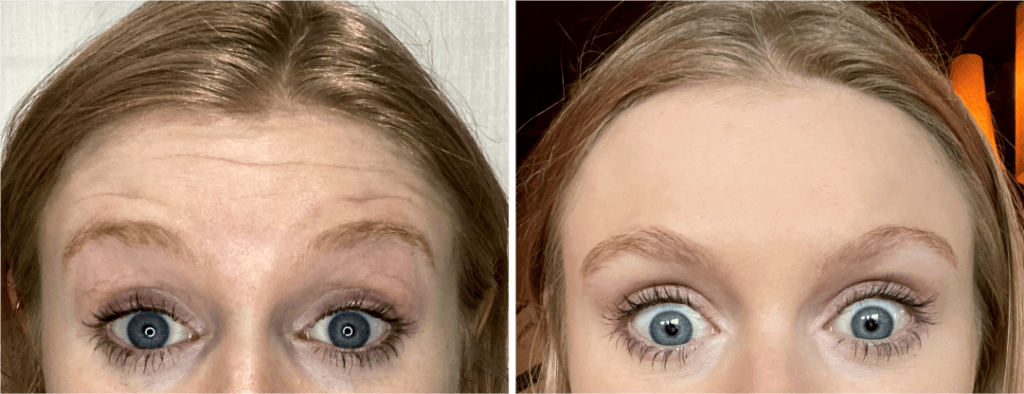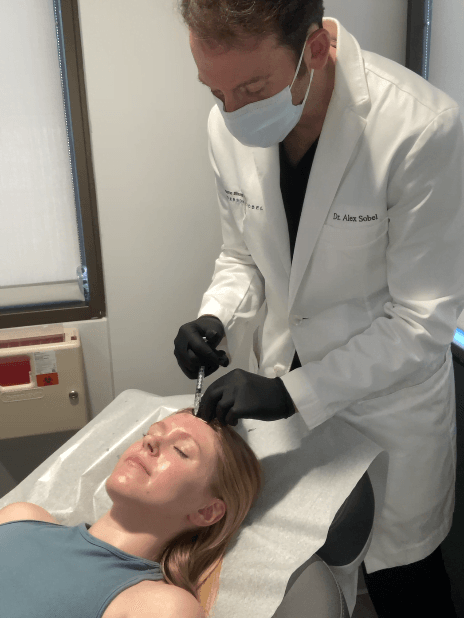You may be disappointed if you only get Botox in the forehead. A cosmetic surgeon explains why
 With Botox, less isn’t always better. A cosmetic surgeon explains the nuances of forehead Botox.
With Botox, less isn’t always better. A cosmetic surgeon explains the nuances of forehead Botox.
So you want Botox® to treat your forehead lines. You don’t have any other wrinkles, so you’ll just need one area of Botox—the forehead—right? Actually, using Botox in the upper face is not so cut-and-dried: the forehead area should almost always be treated along with the frown lines, or the 11s between the eyebrows, to avoid a brow ptosis (a sagging, heavy brow).
This is just one example of how nuanced the injectable “lunch break” treatment can be, despite being used by millions of Americans. Beyond the forehead and frown lines, Botox can treat numerous other areas to create comprehensive facial rejuvenation. From crow’s feet and bunny lines to jawline slimming and neck bands, strategic multi-area treatment delivers the most natural, harmonious results.
In this post, board certified cosmetic surgeon Dr. Alex Sobel explains the nuanced use of Botox in the forehead and between the eyebrows.

Treating the forehead lines with Botox
Your horizontal forehead creases are caused by the frontalis muscle. This muscle vertically hugs the forehead bone. When contracted, i.e. when you raise your eyebrows, the skin that lies over this muscle forms horizontal wrinkles, which, with repeated motion, become permanently etched into your skin. To stop these wrinkles, Botox is injected into this muscle in a zig-zag pattern across the upper forehead; the medication partially relaxes the muscles and temporarily limits these contractions.
How your injector examines your anatomy
The location of your forehead Botox injections and the amount of product placed at each site should be carefully considered based on a few anatomical factors, including:
- Your natural wrinkle pattern
- Any irregularities or asymmetries in muscle contraction
- The width of your forehead
- How close wrinkles form to your hairline
- How far towards the temporal ridge that the creases extend
Rules of thumb for Botox above the eyebrows
1. Only partially treat the muscles
As injectors, our aim is always to partially treat the forehead so that you still have enough muscle movement to support the eyebrows. If we over-treat the width of the forehead, your eyebrows “settle” and you begin to look tired. The heavy brows can even weigh on the eyelids, temporarily making them appear more hooded.
A skilled injector ensures that Botox is placed precisely where it will yield the best aesthetic results while maintaining the natural movement and function of the facial muscles.
2. Inject the right amounts in the right areas
The injection amounts you need may be evenly placed across the forehead, or adjusted for certain asymmetries or your wrinkle pattern. A balance across the width of the forehead is critical: If we inject too much at the sides of the forehead, you could see a flattened arch in the eyebrow, but still have movement at the center, causing you to look sad or concerned. If we inject too much in the center of the forehead, a patient may end up with a surprised-looking, checkmark-shaped eyebrow—where your center eyebrows droop a bit, and the tails of the brows arch high at the sides.
3. Inject within safe boundaries
When your injector plans out your treatment, they should carefully plan around areas where injecting is not safe: we avoid injecting too close to the eyebrow’s tail (at the lower part of the forehead) since this could make the brow sag. It’s also key not to inject beyond the ridge where your temple begins.
Injecting outside of the safe boundaries increases the risk of affecting nearby muscles that should not be influenced by Botox. This can lead to unintended muscle weakness in areas such as the eyelids or even parts of the face involved in smiling and other expressions, resulting in an unnatural or “frozen” look. In severe cases, it might even impair muscle functions critical for basic facial movements.
4. Treat the frown lines, too
For best results, the forehead lines should never be treated alone—they should always be paired with treatment of the frown lines (in the glabella area). Located between the eyebrows, the “11”-shaped frown lines form because of the movement of the corrugator muscles, which squeeze the brows together and lower them into a frown.
Technically speaking, frown lines can be treated without also treating the forehead lines, but the reverse is not true: if you skip the frown lines and just treat the frontalis—which naturally lifts the forehead up—then the downward force of the relaxed forehead may over-intensify your “focusing” or “interested” faces. To counterbalance this effect, it’s ideal for most patients to have the forehead treated along with the frown lines: the forehead “relaxes down” and the corrugators “relax up,” creating a balance of the two opposing forces for a fresh, pleasant appearance.
Forehead anatomy is highly variable, and aesthetic goals are, too—so your injector needs to be nimble with how they apply the principles they’ve learned to suit your unique case.
Like any rule, there can be exceptions, as the forehead varies widely from patient to patient. That’s why it’s key to choose an injector who understands how the frontalis and corrugator muscles work together to form each individual’s facial expressions. An experienced injector will also be sure to go light on the forehead lines in your first appointment as they learn how Botox affects your features. (You can always return to your injector for a touch-up if you are unhappy with your developed results after two weeks.)
Choose a medical injector with specific training in neurotoxin
While it is wise to do your research before receiving injectables, the most critical way to prepare is by choosing an injector with training and experience you can trust. Seattle cosmetic surgeon Dr. Alexander Sobel is triple-board certified with fellowship training in injectables and a full range of aesthetic procedures for the face, breast, and body. He holds many years of experience in offering these treatments, and is passionate about educating his patients, thereby empowering you to make meaningful choices in your treatment plan.

Not only is Dr. Sobel highly trained in facial anatomy, but he is also able to suggest alternative treatments or “tweakments” you may not have considered, such as dermal filler to address volume loss. And if you should become interested in more transformative results, Dr. Sobel is here to consult with you about minimally-invasive and surgical options, as well.
Schedule your Bellevue Botox consultation with Dr. Alexander Sobel
To schedule your consultation and learn how Dr. Sobel can help you reach your goals, call 425.453.9060 or fill out our online contact form today.
Areas served: